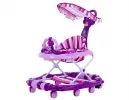Jan. 09, 2024
Home & Garden
When it comes to choosing a walker for your baby, it's essential to prioritize safety, comfort, and developmental benefits. There are various types of walkers available in the market, but selecting the right one depends on your baby's age, developmental stage, and personal preferences. Here are some considerations to help you choose the best walker for your baby:
Stationary Activity Centers:
Advantages: These are typically designed for younger babies who may not be ready to walk but can enjoy interactive toys and activities. They provide a safe environment for babies to play and explore while remaining stationary.
Considerations: Ensure that the activity center has a stable base to prevent tipping. Look for features that stimulate sensory development, such as colorful toys, mirrors, and textured surfaces.
Sit-to-Stand Walkers:
Advantages: These walkers have a detachable seat that allows younger babies to sit and play. As your baby grows and gains more strength, the seat can be removed, transforming the walker into a support for pulling up and taking those first steps.
Considerations: Check for adjustable height settings to accommodate your baby's growth. Choose a model with a wide base for stability.

Traditional Walkers:
Advantages: These are classic walkers with wheels that allow babies to move around while holding onto a handle. They are suitable for older infants who have gained more control over their movements.
Considerations: Opt for walkers with features like non-slip pads, sturdy construction, and a built-in safety mechanism to prevent falls down stairs or uneven surfaces. Ensure the walker is the right height for your baby to avoid strain.
Push Walkers:
Advantages: These multifunctional baby walkers are designed for babies who are already taking independent steps. They offer support for practicing walking and often come with interactive features.
Considerations: Look for a push walker with a wide and stable base, a comfortable handle for the baby to grip, and resistance that allows for controlled movement. Ensure it has a design that encourages proper posture and balance.
Convertible Walkers:
Advantages: These versatile walkers can be adapted to different stages of your baby's development. They often transform from stationary activity centers to sit-to-stand walkers and then into push walkers.
Considerations: Check the transition mechanisms and make sure they are easy to use. Look for a convertible walker that aligns with your baby's developmental milestones.
Safety Features:
Regardless of the type, prioritize safety features such as locking mechanisms to prevent the Lightweight baby walker from rolling down stairs, non-slip materials on the bottom, and a design that minimizes the risk of tipping over.
Reviews and Recommendations:
Read reviews from other parents and caregivers to get insights into the durability, safety, and overall satisfaction with a particular walker. Recommendations from trusted sources can guide you in making an informed decision.
Always remember that a walker is a tool to aid in your baby's development, not a substitute for parental supervision. Regularly inspect the baby walker for any signs of wear and tear, and follow the manufacturer's guidelines for use and safety. Additionally, consult with your pediatrician to ensure that the chosen walker aligns with your baby's individual developmental needs.
If you are interested in sending in a Guest Blogger Submission,welcome to write for us!
All Comments ( 0 )